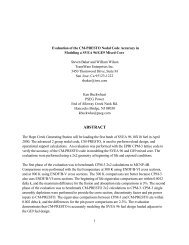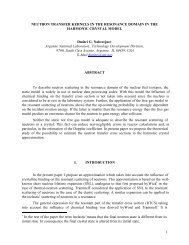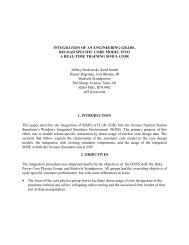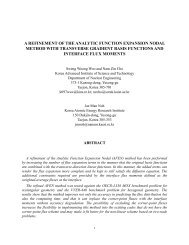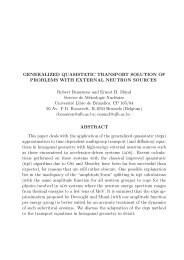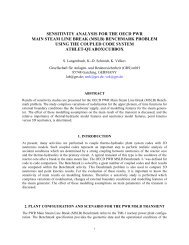Ellis
Ellis
Ellis
Create successful ePaper yourself
Turn your PDF publications into a flip-book with our unique Google optimized e-Paper software.
The agreement for the boron reactivity worths is very good for all the cases and for all the<br />
burnup levels. The overall comparison is that the ratio of TVS-M to HELIOS boron reactivity<br />
worths is 1.0049±0.0014; for higher burnup results, the trend is that the TVS-M value is slightly<br />
smaller than the HELIOS result, while at lower burnup, the TVS-M result is greater than the<br />
HELIOS result.<br />
The reactivity effect of the isothermal reactor temperature increase includes the associated<br />
density change in the coolant [the density of the coolant decreases by 23.9% when heated from<br />
20C to 280C], the Doppler effect of the fuel, and all other temperature reactivity effects. For<br />
coolant with boron, the expansion of the coolant upon temperature increase results in a<br />
corresponding decrease in the boron concentration and a significant reduction in the reactivity<br />
load of the coolant.<br />
For fresh fuel, with coolant without boron, the reactivity effect of the temperature increase is<br />
negative for all the different design options simulated. The full MOX LTA values is more<br />
negative than the value for the Island LTA, while the value for the LEU assembly is slightly less<br />
negative than the Island LTA.<br />
For the LTA models, for fresh fuel and low burnup fuel (0-10 MWd/kgHE) the magnitude of the<br />
TVS-M result is slightly smaller than that of HELIOS. The ratios of the TVS-M to HELIOS<br />
results at 20 MWd/kgHE are essentially equal to 1. For higher burnup fuel (30-40 MWd/kgHE)<br />
the TVS-M to HELIOS result ratio is greater than one (about 1.077±0.014).<br />
For coolant with 1200-ppm boron, the reactivity effect of the temperature increase is positive for<br />
the Island LTA and slightly more positive for the LEU assembly. For the full MOX LTA<br />
designs, for fresh fuel, the TVS-M results for the reactivity effect are very small and positive but<br />
the HELIOS results are very small and negative. For fuel with burnup, the reactivity effect of<br />
temperature increase is positive for all the cases. With increasing fuel burnup, the HELIOS<br />
result becomes increasingly larger than the TVS-M result: at 40 MWd/kgHE, the HELIOS result<br />
is about 1.298±0.003 times larger than the TVS-M temperature reactivity effect.<br />
4. VOID REACTIVITY EFFECTS 8 FOR LEU AND MOX FUEL IN PWRs<br />
A series of studies was performed to assess the void reactivity effect of pressurized-water<br />
reactors uniformly fueled with pins of LEU or MOX fuel. The first study considered the void<br />
reactivity effects caused by a 10% void (reduction in coolant density) in VVER and PWR<br />
models for LEU, WG MOX and RG MOX fuel. An additional case looked at the relative<br />
reactivity effects of coolant density change and the separate coolant temperature change for a<br />
simulation case with a nominal 10% reduction in coolant density. A major scoping study was<br />
completed to calculate the behavior of void reactivity for pressurized-water reactors for a wide<br />
range of LEU fuel enrichments and WG and RG MOX fuel Pu-content levels.<br />
5



